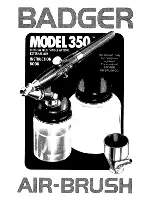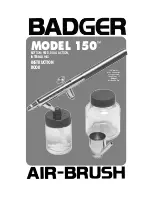
Pressure Relief Procedure
Be sure to follow the pressure relief procedure when
shutting the unit down for any purpose, including
servicing or adjusting any part of the spray system,
changing or cleaning spray tips, or preparing for cleanup.
1. Lock the gun by turning the gun
trigger lock to the locked position.
2. Turn off the unit.
a. To turn off the gas engine,
• set the pressure to minimum
by turning the pressure control
knob fully counterclockwise,
• move the throttle lever to the
slow position, and
• turn the engine switch to the OFF position.
b. To turn off the electric motor,
• set the pressure to minimum by turning the pressure
control knob fully counterclockwise,
• move the ON/OFF switch to the OFF position.
3. Close the hydraulic shut-off valve on the hydraulic
pressure hose.
4. Unlock the gun by turning the gun trigger lock to the
unlocked position.
5. Hold the metal part of the gun firmly to
the side of a metal waste container to
ground the gun and avoid a build up of
static electricity.
6. Trigger the gun to remove any pressure
that may still be in the hose.
7. Lock the gun by turning the gun trigger lock to the locked
position.
8. Place the bleed hose into the metal waste container.
9. Open the bleed valve by turning it fully counterclockwise.
Cleanup
Special cleanup instructions for use with flammable
solvents:
• Always flush spray gun preferably outside and at least one
hose length from spray pump.
• If collecting flushed solvents in a one gallon metal
container, place it into an empty five gallon container, then
flush solvents.
• Area must be free of flammable vapors.
• Follow all cleanup instructions.
The sprayer, hose, and gun should be cleaned thoroughly
after daily use. Failure to do so permits material to build
up, seriously affecting the performance of the unit.
Always spray at minimum pressure with the gun nozzle tip
removed when using mineral spirits or any other solvent
to clean the sprayer, hose, or gun. Static electricity
buildup may result in a fire or explosion in the presence of
flammable vapors.
1. Follow the “Pressure Relief Procedure” found in the
Operation section of this manual.
2. Remove the gun tip and tip guard and clean with a brush
using the appropriate solvent.
WARNING
CAUTION
WARNING
Trigger lock
in locked position.
WARNING
3. Place the siphon tube into a container of the appropriate
solvent.
Use only compatible solvents when cleaning out oil based
enamels, lacquers, coal tar, and epoxies. Check with the
fluid manufacturer for the recommended solvent.
4. Place the bleed hose into a metal waste container.
5. Set the pressure to minimum by turning the pressure
control knob fully counterclockwise.
6. Open the hydraulic shut-off valve located on the hydraulic
pressure hose. The handle should be in line with the hose.
7. Open the bleed valve by turning it fully counterclockwise.
8. Start the engine or turn on the electric motor.
9. Allow the solvent to circulate through the unit and flush
the paint out of the bleed hose into the metal waste
container.
10. Turn off the unit.
11. Close the bleed valve by turning it fully clockwise.
12. Start the engine or turn on the electric motor.
Ground the gun by holding it against the
edge of the metal container while
flushing. Failure to do so may lead to a
static electric discharge, which may cause
a fire.
13. Trigger the gun into the metal waste container until the
paint is flushed out of the hose and solvent is coming out
of the gun.
14. Continue to trigger the spray gun into the waste container
until the solvent coming out of the gun is clean.
14. Follow the “Pressure Relief Procedure” found in the
Operation section of this manual.
15. Store the unit in a clean, dry area.
Do not store the unit under pressure.
CAUTION
NOTE: For long-term or cold weather storage, pump
mineral sprits through the entire system.
WARNING
Pressure Control
Knob
Bleed Valve
Hydraulic Shut-off
Valve (in open
position)
CAUTION
© Titan Tool Inc. All rights reserved.
9
English










































